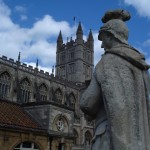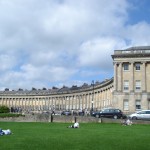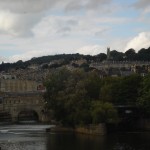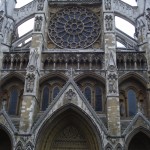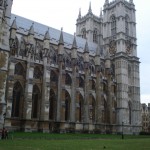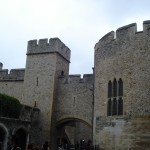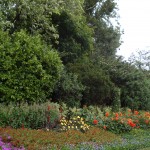Entries Tagged as 'Churches and Cathedrals'
September 15th, 2009 · No Comments
Closed. Come 6:00 PM on a Sunday evening and this sign is sure to greet you wherever you go in London. As I’m from small town Ohio, closing around this time on a Sunday is nothing new to me. When my classmates pointed out their frustrations about this pattern, I just shrugged it off. After all, it’s Sunday and everyone is taking the day to go to church and be with family right? Maybe the later half but definitely not the former in regards to life here in London. Everyone will take the day off to be with family and go to the pubs. So, I guess I should revise my opening sentence. Everything other than pubs closes in London at 6:00 PM on a Sunday. What an interesting situation though. A city that boasts St. Paul’s Cathedral and Westminster Abbey as two of its most important attractions, London on the surface seems to be quite proud of its church-respecting and outwardly seeming church-going nature. Upon further reflection, however, the churches in London seem to be used for everything but that.
Upon entering Westminster Abbey or St. Paul’s Cathedral, two magnanimous symbols of the city of London, the agnostic tourist or devout Anglican alike are necessarily awe-struck – indeed, that was the effect intended by these buildings’ creators. Perhaps what is more staggering to the visitor than the architecture or sheer size of these spaces is the opulence of the details which adorn them. The ceiling of St. Paul’s cathedral glitters with thousands of gilt mosaic tiles; In Westminster Abbey, the spires, cornices, corbels and tiny arches build into a gilded backdrop to the altar is transformed into a miniature castle by the noonday sun; In both venues, the admirer can surely imagine just how many painstaking hours went into the woodcarving of furniture, panels and memorials.
It is this opulence which both infatuates and disturbs me. “How many mouths could all of this have fed?” I must ask myself upon entering a space like St. Paul’s or Westminster Abbey. Do the benefits – if one considers drawing people to an already corrupt church a benefit – of building such an extravagant structure outweigh the drawbacks, namely profligacy? Why are there dress codes? Didn’t Jesus Christ, the core of the Anglican religion, say “come as you are?” Why are there no homeless or down-trodden seen around these churches? It would be logical to assume that they are shooed away and out of sight, because, surely, tourists don’t want some anonymous, starving, sunken-eyed man blocking their shot of the beautiful gothic architectural detailing. This contrasts starkly with Luke 9:48: “Whoever welcomes this little child in my name welcomes me; and whoever welcomes me welcomes the one who sent me. For he who is least among you all—he is the greatest.” And the hypocrisy can still be seen today…
…The primary functions of Westminster Abbey and St. Paul’s Cathedral are no longer to serve as places of worship, but rather, to serve as tourist destinations and symbols of the city of London. It is ironic that the modernized and secularized London should chose religious institutions as their symbols. However, it could be argued that the Londoner no longer looks at these spaces as sacred – indeed, Londoners have bastardized them by building cafes, bookstores and giftshops within the cathedral walls – but rather, as opportunities for profit, an idea which will be more fully developed later.
As demonstrated above, churches today seem to be used for the revenue they can bring in- they seem to be machines for monetary gain. That isn’t to say that all churches fit this classification though. Smaller churches that hold much more modest services seem to still operate with their main goal being to act as a place of worship. It’s important to note here that these churches are not only few and far between but also are in need of some of the monetary attention given to the other more commodified ones.
The difference in monetary prominence and traditional religious practices between the iconic churches of London and the smaller churches can be easily seen in comparing St. Paul’s and Westminster Abbey with St. George the Martyr Church in the Bloomsbury area. The later like the other two does have a claim to fame in pop culture: Sylvia Plath was married there. Despite this rather important event in its history, the church continues on as a ‘normal’ one in that it holds modest services throughout the week and has open doors for anyone who would like to pray or worship on their own during non-service times. The walls are chipping, the ceiling is in need of repair, a few light bulbs could use replacing- the church isn’t a collection of bedazzling and impressive sights; quite the contrary, its simplicity characterizes it most thoroughly. The staff welcomes you with smiling faces to come in and have a look around but they don’t fuss over you at all. They don’t try to make you feel overly comfortable, they don’t make sure that you only look at the pretty parts of the church, they don’t make sure you have the most delightful visit of all time so that you’ll come back and bring all your friends. They do welcome you, allow you to experience the church on your own, and they leave the decision of whether you want to come back or not as completely yours. What I’m trying to get at but not saying incredibly directly is that they don’t try to butter you up to both take your money and have you spend some at the gift shop too. They don’t even have a gift shop. They have a place of worship to which they would love for you to come back on Sunday at 9 to join in their services.
We can’t make a generalization of how this pattern in churches speaks to the religious piety of the city nor is that something we want to even try to do. Mosques, gurdwaras, synagogues, many other places of worship are quite present in London. Our experiences with the churches of the city though have shown us that this type of presence alone doesn’t necessarily correlate to any felt sense of spirituality. We’re not here to analyze whether this is ‘good’ or ‘bad’ or ‘right’ or ‘wrong’. We are here to observe this and begin to process how this helps us examine the rather complicated London identity.
Tags: Anya · Audrey · Churches and Cathedrals
September 14th, 2009 · No Comments
Although I have blogged, to some extent, about most academic things I have done in London, I feel that I have a better impression of most things now than I did at the beginning of the stay. Along this vein, I feel the need to revise, or just plain state, my opinions on the “Big Five” topics – parks, churches, museums, theatres, and pubs.
I have now been to five of the Royal Parks in London. Green Park, Kensington Gardens, Hyde Park, Regent’s Park, and St James’ Park are all very similar and yet very different in their own ways. I found Green Park, situated very close to Buckingham Palace, to have the most unfriendly atmosphere of the five. There is very little to Green Park. There are trees, benches, grass, the ever-popular lawn chairs for rent, and beautiful ornate gates facing Buckingham Palace. I think the reason I found the park so cold is that it was, well, too green. There were no flowers or water features (except for one fountain commemorating the Canadians), just trees, grass, and benches.
This is vastly different from the other four parks I visited. St James’ Park, Hyde Park, Regent’s Park, and Kensington Gardens all were beautifully landscaped with brightly colored flowers, clean fountains, scultpures, and natural or constructed water features. In Hyde Park, Regent’s Park, and Kensington Gardens it was easy to forget that you were in the middle of a pollution-filled city. As I am not much of a city person, it was extremely refreshing for me to not be able to hear or see traffic for a while. With Green Park and St James’ Park, I couldn’t shake that feeling. However, I am a firm believer that parks, whether or not they are within city limits, always make people feel healthier. For this reason and the sheer beauty that the parks portrayed in their different ways, I understand why I did not only see tourists, but the people of London as well.
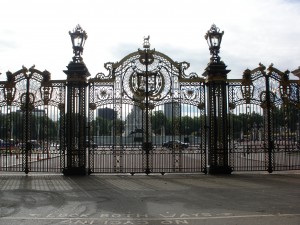
Gates towards Buckingham Palace from Green Park
Churches and other places of worship are an integral part of societies throughout the world. Throughout our time in London, we have been fortunate enough to visit Westminster Abbey, St Paul’s Cathedral, a Sikh gurdwara, and a Hindu temple. Of these four I enjoyed St Paul’s Cathedral the most from a purely historical standpoint and the Hindu temple most from a cultural perspective. St. Paul’s is one of the most recognizable and interesting buildings in London. It not only houses some of the most important military remains in the country (the Duke of Wellington and Admiral Nelson), but it was one of the most iconic images of WWII Britain. I also found it to be less like a museum where I felt like hop-scotching around graves in the floor (Westminster Abbey) and much more like a place of worship.
I enjoyed the Hindu temple for very different reasons. Although there was a definite sense of it being a tourist attraction, with the gift shop in the lobby and the interpretive centre with tiny models of Hindu gods, the temple was still very obviously, well, a temple. Before going there, I had no idea what Hinduism was like. I knew that there are multiple gods and that one is an elephant, but I didn’t know about their dedication to peace and volunteer work. What really struck me about it was that the intricate carving and craftsmanship of the facility was all done by volunteers. I think that this cultural experience was only heightened by being able to observe a service in the sanctuary that was so unlike my own Roman Catholic faith.

St Paul's Cathedral - a symbol and a place of worship
I had very mixed experiences with museums in London. Some, like the Victoria and Albert, I just didn’t seem to understand in the amount of time I spent there. However, I think that if I went back and dedicated a day to the facility, I would appreciate how the seemingly-random exhibits link together much better. (I did enjoy the items on display in the V&A, I just had an issue with the layout of the museum.) Other museums, like the Museum of London and the Docklands Museum, were put together in a very fluid and informative manner that I enjoyed greatly. My two biggest museum issues were with the British Museum and Sir John Soane’s Home/Museum. Grace and I wrote extensively on our thoughts on the British Museum, so instead of repeating everything, I’ll just give a brief summary: why are all of these amazing artifacts that have no connection to Britain in the British Museum?
The Sir John Soane Museum is a completely different story. I appreciated that the museum was free and displayed an extremely eclectic collection, but please never make me go back there ever again! It was the single most claustrophobic place I have ever been in my entire life with possibly one exception. Call it a personal thing, I do not like it when random pieces of monuments are mounted on the ceiling directly above my head. I am also not a big fan of walking into a room in a house and having literally hundreds of sculpture eyes staring at me from every surface around me. I disliked it so much that I could not even finish going through it, and anyone who has been in a museum with me will know that I read and see as much as I possibly can. I don’t understand why that creepy building perfectly-suited to be a haunted house at Halloween is called a museum. (Please if you can attempt to explain it to me, go right ahead!)
Theatre is a subject I have talked about in a couple of different posts (Observations on Accessibility and Blood Painters and Pitmen Brothers), however, I have not discussed theatre in general. I was lucky enough to see Troilus and Cressida, All’s Well That Ends Well, Arcadia, The Pitmen Painters, and Blood Brothers. Each of these theatre experiences were extremely different, but all valuable in their own ways. Troilus and Cressidawas shown in the Globe Theatre and we had groundling tickets that forced us to stand for the 3 hour performance. The actual standing wasn’t nearly as bad as I thought it would be, but the best thing about the show was being quite literally three-to-four feet away from the actors on stage. (Actually, it was slightly amusing when Hector died and was lying 3 feet away in our line of sight for the last 20 minutes of the play!) The staging of this Shakespearian play was vastly different to All’s Well That Ends Well, which was put on in the National Theatre. In the Globe, the sets are quite minimal because they have to perform four or five different shows on the same stage in the space of a few days. The set for All’s Well That Ends Well was much more elaborate and specialized for the show. Rather than the reliance on the actors and the costumes that the Globe used to tell you where the play was occurring, All’s Well That Ends Well used a dark set with elaborate staircases to add to the mood of characters and the dialogue.
Much like with Troilus and Cressida, the set for Arcadia was also pretty simple. Although the play took place in two different years, it was set in exactly the same room with almost all of the same props. This was a very effective way to stage the show and allowed for the writer, Tom Stoppard, to do some very interesting things with the characters from both time periods, like when he had them all in the room at the same time, oblivious to each other. I particularly enjoyed the way that this play was set and how basic it was. It was vastly different from the more complicated sets of The Pitmen Painters, which included projection screens, and Blood Brothers, which had lots of windows for the Devil/God character to peer creepily out of.
This final subject I have not blogged about at all. Pubs are an integral part of British culture. That said, pubs are also an integral part of Irish culture, so I experienced pub life when I lived in Ireland. British pubs and Irish pubs have a lot of similarities and differences. In both places, you must push viciously up to the bar in order to get your food and drink, you have to be 18 to have alcohol, smoking must be done outside, and there are usually way too many people in the pub for you to feel comfortable. Oh, and you always pay way more than you think you should for your drink. I’ve been to a couple of pubs in London and have found that they are all fairly similar. The bartenders are nice, but kind of frantic; the food is good, and usually relatively cheap; and the music is God-awful 1980s or techno playing at volumes that are way too loud. The first two are cohesive with pretty well every Irish pub I’ve ever been in, the third is not. Irish pubs play good music… or at least much better music than I’ve heard here! There are a lot of pubs that have a band playing traditional Irish music in front of you in the pub for pints and there are also a lot that play modern music at volumes that make my ears want to cry – but at least the music isn’t a Cher and Meatloaf duet accompanied with the weirdest music video I have ever seen in my entire life. (This particular musical masterpiece was played in The Court the other day. I never would have thought of that particular combination, but oooooookkkkkkkkkk.) Truth be told, I just want to find a comfortable pub with some good music and that will make me just as happy as George Orwell’s fictitious Moon Under Water.
Tags: Churches and Cathedrals · Kelley · Museums · Pubs · Theatre
September 7th, 2009 · 2 Comments
During our time in London, we have noticed that many of the religious institutions we have been visiting rely on gift shops and cafés to increase revenue. Some basic internet research shows that many people have mixed feelings about whether or not this practice is acceptable. Generally speaking, we do not believe it is necesarily inappropriate for a church or temple to sell refreshments or gifts related to the location or religion. Given a decrease in European religious sentiment and worldwide economic difficulty, donations aren’t a very reliable source of funding. If a place is to be kept open to a public (tourists and worshipers alike) it needs money to run. Employees and utilities need to be paid and maintenance isn’t cheap. It’s easy to understand the rationale behind the decision to open a shop.
For the most part, the places of worship we have visited had signs informing the guest that the proceeds from the shop or café benefit either local charity or the building itself. For example, St. Martin’s in the Fields’ gift shop benefits “the work” of the church. Additionally, the products sold are related to Christianity, the church itself, and the church’s location. Furthermore, the Shri Swaminarayan Mandir‘s gift shop sold incense, prayer beads, and other products Hindus would need for everyday use in addition to more “touristy” items. We consider all odthese items to be appropraite for such a shop; they are directly related to the place and its purpose.
Whilst visiting the Christ Church College in Oxford (this may or may not have been related to Harry Potter), we stumbled into “The Cathedral Shop” adjacent to the college’s chapel. Most of the items sold by this shop were very similar to the other gifts shops we previously encountered. There were chalices, books, t-shirts, postcards, etc. There was a fairly modest Harry Potter section relating the the films that were partially created at the location alongside a small section dedicated to Lewis Carroll’s Alice in Wonderland, which was written in Oxford.
However, we did notice a few items that did not seem appropriate for a shop entitled “The Cathedral Shop.” Instead, they seemed to be trying VERY hard to appeal to young, hip buyers:

The last time we checked, no religion condones binge drinking and sleeping until 4pm and Oxford isn’t particularly famous for its hangovers.
We’re curious to see what everyone else in the group thinks about the idea of gift shops in religious buildings and what kinds of items they should sell.
Tags: Alli · Churches and Cathedrals · Sarah
So arriving in London two weeks ago I have dove into a world of museums, churches, and recognizable landmarks (some of these locations encompassing all three of these aspects; ie. Westminster Abbey/St Paul’s ). As I read my other classmates blogs about these locations I was less than inspired though to throw my two-sense into the conversation. However after visiting the Sikh gurdwara I realized that discussing the architecture or the history of these churches was not what I was interested in. Rather, my focus was on the spirituality and religious nature of these locations (or lack there of as the case may be).
I’d be crazy not to acknowledge Westmnister Abbey’s incredible architecture– the dedication to style as additions were made to the building, the multitude of famous persons from his or her particular field buried in the ground of the building. I had the same reeling of awe walking around St. Paul’s Cathedral. The detailed stained glass windows, the enormous dome, the ceremonial burial sites all over the building—they are images I will remember forever. However, as I left both of those places I felt more like I was leaving a museum than a church.
Because of this feeling I decided to stay at St. Paul’s for evening song. It was a beautiful service, but I continuously found myself distracted by the other tourists walking up and down the church looking at all of the graves. I hoped that I would find myself in a state of spiritual prayer, but only found myself frustrated. I had a similar reaction when I sat in on Holy Communion at Bath Abbey. Sitting in another beautiful church, trying to take in and appreciate the holiest of sacraments and all I could focus on was the people going in and out of the attached gift shop.
While also in Bath I decided to wander down random alleys exploring the city. It was here where I ran into St. John the Evangelist, a Roman Catholic Church. Being the first Catholic church I had seen since arriving I decided to go in. Assuming to find myself surrounded by graves and gift shops yet again, I was in disbelief to find myself in one of the most beautiful churches I have ever seen. No gimmicks. No crowds. Beautiful architecture. Amazing stained glass. And peace. I couldn’t even tell you how long I just sat there, engulfed in the church’s beauty and feeling of spirituality.
When I attended St. Patrick’s in SOHO for a service I hoped I would feel the same sense of peace I did in Bath, but was slightly disappointed not to. I’m not sure why, but I’m hoping as I continue to investigate churches in both London and Norwich I will find a common thread in why I find some churches and temples more spiritual than others.
**I wrote this last night, and I thought it had posted. And now after visiting the Hindu temple I have even more thoughts on this subject, but will expand later. **
Tags: Amanda · Churches and Cathedrals
August 30th, 2009 · 1 Comment

Westminster Abbey
Yesterday, I stood on Charles Darwin’s grave. And no, it was not in a cemetery or science sanctuary, it was in a church. Over 3,000 people are buried at Westminster Abbey. While it is mainly dominated by various royal figures, there are several burials and memorials for literary figures, scientists, and even an unknown soldier. But by far the most shocking person buried there is Charles Darwin. Despite the fact that in many ways his work refutes the teachings of the church, he is still honored there as an important historical figure. This illustrates the importance of English history to the English, to the point where they would rather honor a historical figure who they disgraced with than have his part of history lost.
As an English major, there was also another part of the church I particularly liked: poet’s corner. There I saw stones for many writers including D. H. Lawrence, Lewis Carroll, and Dylan Thomas. However, I was disappointed to realize that not everyone who had a stone on the ground was really buried there. I later learned that these stones served mainly as memorials to recognize these artists’ efforts. One the bright side, I did stand on Charles Dickens, who is actually buried in the church next to Rudyard Kipling.
All these sanctuaries, memorials, and graves, some with carving or detailed sculptures of the deceased present set me thinking about death rituals. The more we looked at these secularized burial spots , the more they began to resemble the Egyptian burial traditions. My knowledge of their practices is limited, but to my understand the Egyptians bury their dead in elaborate tombs with gold and riches to prepare them for the afterlife. And I looked at the extravagant sculpture of Queen Elizabeth lying about her body I began to wonder what the purpose of this whole thing was. Who was really being honored here? Queen Elizabeth? The artist? The patron or surviving family members? Or even the church itself?
And amongst these thoughts, as I walked the tours, the announcement came on for a moment of prayer, it was 11:00. And out of these thoughts of vain royalty, religious celebrations, or tourist attractions, I was reminded that we were in a place of worship, a house of God. And these people were lying here to be with God and to be remembered. These ornate carving and statues were not meant to honor the person, to prepare them for the afterlife, or even to make Westminster Abbey the tourist attraction that it is today; they were made to honor England’s history. Everyday people visit Westminster Abbey and they worship this country’s history.
To view a slideshow of photos from my time at Westminster Abbey, The National Gallery, and the South Bank please click here.
Tags: Churches and Cathedrals · Megan
August 29th, 2009 · 1 Comment
Last Thursday morning at 8 a.m. both the Humanities and Science programs piled on a bus and began our first journey outside of London since arriving almost exactly a week before. Our first stop on the journey was Stonehenge. Going into it I had mixed feelings about this collection of rocks. From what I had seen on television and from what I had read about Stonehenge they seemed so mysterious and fascinating. I guess I was worried that actually going to Stonehenge would somehow sour their mystique to me. I didn’t want something that I had always considered so majestic to all of a sudden lose its aura of greatness. In addition I had been told by friends who had been on the Norwich Humanities program before that Stonehenge did not meet their expectations.
After about a two hour bus ride we pulled off a highway and at the top of a hill we saw our destination in the middle of a field. Upon arrival Aidan and I joked about the famous scene in “This Is Spinal Tap” where the band accidentally receives miniature Stonehenge models for their rock concert that are about half the size of dwarves that are dancing a jig around them. Once I received my electronic tour device I headed up to the top of the hill where I proceeded to take a multitude of pictures from all angles and vantage points. The tour device was helpful and helped me understand the figure as more than just a pile of rocks. Overall I was not disappointed by Stonehenge and it did not lose its mystique for me but I was glad that we only spent an hour at the site. There really isn’t much to do there once you’ve listened to the tour and used up every picture angle possible.
The next stop on our trip was Bath. Unlike Stonehenge I had heard only positive things about this part of the journey so I went in with fairly high expectations. At the end of the day my expectations were more than satisfied. The ride from Stonehenge to Bath took us through some beautiful English countryside. We passed some classic country houses and weaved in and out of lush valleys the whole journey. While listening to “Stairway to Heaven” on the bus ride over I attempted to envision Robert Plant and Jimmy Page sitting in the countryside right outside my window, strumming guitars and trying to come up with lyrics for their ’71 masterpiece. As we approached Bath I was immediately impressed by the architecture I observed in the distance. Many of the houses sat on top of a hill separated by a river. A truly remarkable sight.
Once we arrived a bunch of us headed off to find a place to eat lunch. We decided on a half pub/diner type of restaurant where I ordered the Pie of the Day. Overall the food was mediocre for its price. I’m still having a little trouble distinguishing which restaurants appeal to me and which don’t. When in doubt the Fish and Chips in any pub is usually a great choice for me. After lunch we headed to Bath Abbey before our class trip to the Roman Baths. Bath Abbey was gorgeous. Not quite as remarkable or as massive as Westminster but definitely in the same ballpark. Already sensing that the town of Bath would be a place to remember I bought a few postcards in the gift shop and headed over to the baths.
Overall seeing the baths was a great experience. It is amazing and a little disconcerting to me to think that hundreds of years ago a multitude of men bathed in the very same spot that we were walking around in casually and taking pictures. The columns and statues of Romans surrounding the large bath were beautifully done. The water was an odd colour of green so for anyone that would have been tempted to touch it despite the guides warning, this became the final deterrent. I spent about an hour in the Baths before heading up to the Royal Crescent where I would spend the first part of my afternoon. Once I got my fill of the beautiful Georgian Architecture that makes up the crescent I headed over to the park across the street where a bunch of us layed down for about an hour just talking and relaxing.
After a quick coffee break Kelley, Grace and I decided to take a walk around the nearby river. This was easily my favorite part of the trip. The view up the river looking into the town was incredibly picturesque. On this walk I got a sense of the true/non-touristy feel of Bath. There were parks, small trinket shops along the river and even a rugby pitch. Maybe most tourists just don’t have the time for it during their excursions to Bath but the path along the river was wonderful and I would head back there in a heartbeat to explore more of the area.
Overall my trip to Bath helped me conclude a number of things. The first is that, as much as I love being in London, I definitely prefer a smaller town atmosphere a little out of the way. The second thing this trip confirmed is that the English Countryside is just as beautiful as people have told me. Despite my need for sleep on the 2 hour bus ride back to London I resisted because I enjoyed observing the landscape so much. If I have some time later in the year I would definitely return to Bath. There is still a lot to see.
Tags: Churches and Cathedrals · Henry
Walking across the Millenium Bridge tonight (well, it was more like jogging to get out stiffness after three hours as a groundling), I was hit by one of those occasional yet profound moments of realization that I was in London. These moments are few and far between, but when you get a moment to step back and look across the Thames and the glowing lights of the city with St. Paul’s dome looming above you, for example, these realizations can hit you like a ton of bricks.
Similar and not unrelated to the “we’re not in Kansas anymore” feelings are the somewhat more frequent instances of understanding the true amount of history behind London and England themselves. In the past few days, I have seen Stonehenge, Roman baths, Medieval cathedrals, prisons, and fortresses, a Shakespeare play, the Jane Austen Centre, the Cabinet War Rooms, and the Tate Modern. The sheer number of years represented by those few landmarks and events is mind-boggling and can serve to disorient the visitor (especially when the visitor comes from a country that’s only approximately 200 years old). I find it interesting to note that I have an almost reverse levels of admiration for the feats and landmarks viewed: I found it utterly astonishing that ancient peoples were able to move stones weighing many tons across empty fields and then arrange them in circular patterns, but I was unimpressed and even disgusted by the artwork of Paul McCarthy digitally projected on a wall with cutting-edge technology at the Tate Modern. I found the stark, bleak nature of the Cabinet War Rooms and the hard work done there to show the strength and resilience of a country under siege, but I found the crown jewels and the grandeur of the monarchy, both past and present, at the Tower of London to be grandiose and over-the-top for a country that is notorious for a “stiff upper lip” and a “keep calm and carry on” sort of mentality.
I suppose what I’m trying to get across is that the sheer nature of hundreds and thousands of years of history (encompassing invasion, multiple great civilizations, and admirable resilience) on a single, small island weighs heavy on a mind that comes from a vast, expansive country with little history at all that can’t even get a healthcare system sorted out. As we now know, you cannot dig down in London without finding something Roman, Medieval, or even prehistoric, yet they still build on and up, layering the present upon the past, and preserving and commemorating as best they can. In my mind, England is a country that seems to be mostly defined by its past, whereas even though America has a shorter history, it seems mostly defined by its present, including its current political standings, fads and trends, and financial influence. London’s ever-changing face and composition always seems to have the same resilient heart, rooted in thousands of years of invasions, shifts in power, influxes of people, devastating disasters, and new technologies, and it appears able to carry on through anything.
Tags: Chelsea · Churches and Cathedrals · Museums
After an early breakfast at the Arran House and a short walk through a light mist back to Trafalgar Square I had a chance to cross some more major sites off my list today. The first of these was Westminster Abbey. The entire class was taken on a thorough tour of the Abbey by John, a knowledgeable, excitable man who made the tour a captivating experience throughout despite the fact that my feet were aching terribly by the end of the two hour experience. Prior to the tour starting I spent a few minutes gazing at the magnificent building from the outside and found myself immediately in awe by both the innate architecture and simply the sheer size of the building. This feeling increased tenfold once we entered. After walking past the courtyard we entered into the nave where I was once again impressed by the beautiful architecture. The tour consisted of a little bit of everything including the tombs of past monarchs, the Grave of the Unknown Warrior and a section dedicated entirely to writers of England. All of these sites caught my attention and stuck with me but my favorite part of the Abbey by far was The Lady Chapel. The many Saints delicately carved into the sides of the room was miraculous. Each one was designed so intricately that even the smallest features were easily discernible. The thing that fascinated me the most inside The Lady Chapel was the Order of the Bath. Each knight in the Order had their own individual flag and seal which they displayed prominently over their seat. Each and every flag was unique and told a different story about the individual that they represent. I found it interesting that knights are sometimes forced to wait a number of years to have their flags displayed because they are required to wait until the person who holds the spot before them passes away before their spot is opened up. After walking through The Lady Chapel I had a sudden urge to design my own flag and copper stall-plate and maybe even start my own Order of the Bath. We will see…
After a pub lunch at the Red Lion, located just a few minutes from the Abbey, Alli, Becca, Chelsea, Kim, Mara, Sarah and I headed to the Tower of London. Heading in with “great expectations” I have to say I was a bit disappointed overall. It was interesting to walk through the ancient monument but I had no idea it would draw the massive number of tourists it did. All ages were represented but I was very surprised to see a large amount of young children walking through the tower, a number of them unaccompanied by adults. The highlight of the Tower of London experience was the Crown Jewel exhibit. After being instructed to put our cameras away we were taken into a room with pressurized doors where we examined crowns that monarchs wore. In addition to the crowns we saw diamond laden rings, sceptors and golden cutlery that made our jaws drop. The most amazing object I observed was a giant punch bowl made entirely out of gold and must have weighed over 18 kilograms. Completely and utterly unbelievable! After the Crown Jewels exhibit my time at the tower went South. Due to the amount of loud, rambunctious children present and a subpar exhibit on torture in the Tower we walked through I was ready to leave after about two hours. Overall my experience was not a completely negative one. Being inside the grounds was breathtaking and the architecture amazed me. However I do not see myself returning here during the rest of my time in London.
After our time in the Tower Alli, Kim, Mara, Sarah and I decided to get an early start on our walking tour project. Since our general theme is parks in London we decided it would be a good idea to visit a couple of the major green spaces in the area. We hopped on the tube and took the central line to St. James Park station. Upon arrival we spent some time moseying around Buckingham Palace and Victoria’s Memorial before getting down to business and taking a stroll through Green and St. James Park. Nothing too exciting was going on at Green Park. At one point we sat down in light green lawn chairs only to be told that we had to pay a fee in order to sit. We quickly dismissed Green Park as a space that we would focus our project on. St. James however was a different story. We immediately spotted water and wandered over where we discovered a multitude of birds including ducks, geese and pigeons. These birds were not afraid to come close to humans at all and we saw many eating out of the hands of children who were offering them bread despite the numerous signs that clearly read “don’t feed the birds”. We wandered through most of the park, passing beautiful lush flower gardens along the way. Overall St. James seemed more alive then Green Park and we definitely plan on heading back to take another look when the Park Office is open and we can receive more information about it’s history.
Today was a very rewarding day overall. I am happy to say that I was able to visit some of the most historic places in the country in one day and ecstatic that my experience at Westminster Abbey went so positively. I’m amazed at just how much I have been able to see in one week here and I know that I continue to see more and more incredible places during my time here in London. Next up: Stonehenge!
Tags: Churches and Cathedrals · Henry
August 26th, 2009 · Comments Off on Light Sounds
Light – unnatural light from the hulking, undoubtedly gilt chandeliers and natural light which poured in through massive, paned windows – set a noonday glow upon the carved stone walls of Saint Martin in the Fields yesterday. The same light spilled onto the crowd that had gathered to watch the performance. For a donation of a few pounds – or nothing, if one desired – appreciators of music of all ages had the opportunity to attend a performance by E.L.F., a trio comprised of a pianist, flautist, and horn player.
The three are known for their versatility, playing anything and everything from classical and pop music to arrangements from soundtracks and musical scores. At St. Martin in the Fields yesterday, E.L.F. stayed true to their reputation, playing a variety of pieces, but none nearly as powerful and interesting as Phantasia, based on Andrew Lloyd Weber’s famous The Phantom of the Opera. E.L.F.’s interpretations of hit songs such as “Music of the Night,” “Past the Point of No Return,” “Masquerade,” “All I Ask of You” and, of course, “Phantom of the Opera” were unexpected and enjoyable. Tempos were adjusted, notes and rests altered to create surprising syncopation, harmonies and jarringly dissonant chords created where none existed previously. At one point during the piece, “All I Ask of You,” a deeply emotional – and during the reprise, truly painful – love song segwayed beautifully into “Masquerade,” a joyful song with an element of whimsy. The transition was unexpected, but surprisingly appropriate and effective.
What else I found to be especially inspiring was the obvious love of the art felt by the performers and the flautist in particular. Even when he was not playing, the flautist made eye contact with his fellow members, smiled, rocked and tapped and swooshed to be beat – or off-beat – of the music, as if all the nerves in his body were firing and playing their own fleshy instruments rather than the flute lying in anticipation at his side.
The light glanced off of the musicians’ instruments as they walked off and bowed to the crowd. The light burned my eyes as I left bliss inside St. Martin in the Fields and walked out into the crush of humanity that is Trafalgar Square. The light left shadows under my feet.

Tags: Anya · Churches and Cathedrals
Sometimes I wonder why I didn’t start a major in social anthropology: I’m utterly fascinated by the tiny, perhaps insignificant intricacies of the way people live in Britain today. What interests me most is not necessarily the greater consequences of large immigrant populations or the history of the development of the city, but the subtle differences between British and American dialects of English and the life of a British school child.
After touring Westminster Abbey and the Tower of London today, I found myself wondering about the contemporary relationship between the British population and the Royal Family and nobles. From what I can gather, the main function of the Royal Family these days is to supply the tabloid newspapers with more scandals and fashion reports, and the real importance of the monarchy remains in the past. However, the fact that the monarchy doesn’t have any political role these days doesn’t keep the pomp and circumstance in check: there were millions of pounds of jewels and gold in the Tower of London which are still used today for official ceremonies. Of course, many of these jewels are from an earlier time, so it’s not as if there are thousands of British taxpayer pounds put into a Royal jewelry fund each year (I assume), though I do wonder what the average Brit thinks of all this formality that seems merely left over from an earlier time. Stereotypically, the Brits seem to have a reputation of being reserved, and the behavior I can see on the Tube, for example, confirms this. Yet the tremendous amount of money, glitz, commemoration, and ceremony put into these old traditions doesn’t seem to equate to the British stereotype. Every case in the Tower of London Jewel House sparkled and every inch of the wall and floor of Westminster Abbey was covered with inscriptions and monuments to royals, nobles, and academics passed. The British seem to like their preservation of history, which is all well and good, but I wonder about the origins of their apparent love of ceremony and honor as well, and how these traditions from ages past fit into the lives and minds of contemporary Londoners.
Tags: Chelsea · Churches and Cathedrals · Museums






